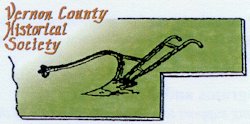
| Home |
| Vernon County Museum |
| Old St. Mary's Church |
| Foreaker Schoolhouse |
| Sherry-Butt House |
| Bookstore |
| Calendar |
| Research Room |
| Become A Member |
| Map Of Viroqua |
| Museum Notes |
| Volunteer |
| Links |
| Contact Us |
Each week a small segment of Vernon County history is published in the county newspapers.
By Carol Krogan, assistant curator
For the week of 7/30/2014
In our continuing series, this week we feature the history of the town of Harmony. The north fork of the Bad Axe River runs entirely across Harmony and provided fresh springs for early settlers. The first white settler was William Struthers, who arrived from Virginia in 1848. He owned 160 acres in section 24, east of Newton. He died in 1899 and is buried in Newton cemetery. David Caulkins, who was born in New Hampshire, arrived in 1850 with his wife Mary. He located on section 23 and they had 8 children. Other early settlers were James Harkness, Orin Caulkins, Elias Rogers, Edmond Rogers, Edward Rogers, Robert Patterson, Samuel Kelsey and John M. Mc Lees.
In
1855, Mc Lees petitioned the county board for the establishment of the
town at which time it was granted. Elected as officers were Robert S.
Mc Michael, chairman; Harrison Keyes, clerk; Horace Keyes, treasurer;
I.L. Smith and Daniel Kelsey, sideboard. The first superintendent of schools
was Orin Caulkins. The town was named after the first post office established
by John M. Mc Lees, the first postmaster, in 1855. It was later called
the Newton Post Office. Mc Lees had 8 sons and there are still descendants
of John and his wife Sarah in the area.
The first religious services were conducted by Rev. Munyon in 1852 and
held in private homes.
A Baptist congregation was organized in 1870, however by 1884 when the History of Vernon County, Wisconsin was published, there were very few members. In 1888 the Zion Lutheran Church was organized during a meeting at the Solfest Bringe home. The church was built in 1893 and dedicated on May 27, 1894. The first pastor to serve the church was Rev. J.G. Aschim and the current pastor is Rev. Peter Beckstrand.
A church building, owned jointly by the United Brethren and Methodist Episcopal congregations, was erected in 1884. This later became the Romance Community Church in 1928 when it was granted to the Ladies Aid Society for $175.00. Members held socials and made quilts to maintain the church and pay a minister. As membership decreased, the church fell into disrepair. It was burned down in 1994 for a road widening project.
The first school house was built in 1856 and was located near Newton. Sarah L. Allen was the teacher. A new school was built at Newton in 1871. During some terms, depending on the size of enrollment, the upper level was used for high school and the lower level for elementary. Other schools located in the town of Harmony were Enterprise, Clawson, Baker, Evening Star, Plainview, South Ridge and Lemke.
Newton was named after Andrew Newton, a blacksmith, who arrived there in 1863. He married Elizabeth Hewitt in 1866. They had five children, Alice, Eugene, Oscar, Mattie and Grace. Grace died in 1880 at age 5 and is buried in Newton cemetery. Orin Caulkins arrived in 1856 and laid out the village that same year. Martin Allen built the first grist mill in 1866.
For
more information about the town of Harmony and its people, visit the genealogy
library at the Vernon County Museum.
![]()
by
Kristen Parrott, curator
for the week of 7/23/2014
A Celebration of Rural School Teachers will be held at the museum this
Saturday, July 26, beginning at 2PM. The public is invited to come honor
alumni of the Vernon County Normal School, most of whom went on to teach
in country schools. Special recognition will be given to alumni who graduated
70 or more years ago.
For the past few weeks in this column we’ve been looking at a sampling of the museum’s collection of Blue Books, the official State of Wisconsin yearbook. This week I pulled out our copy of the 1917 Blue Book, which was the “property of Belgium Ridge School, Jt. Dist. 2, Viroqua,” before it was donated to the museum.
A list of Wisconsin post offices can be found in this Blue Book. As of
October 1916, post offices were found in the following Vernon County communities:
Chaseburg, Coon Valley, De Soto, Dilly, Genoa, Hillsboro, La Farge, Mt.
Tabor, Ontario, Readstown, Rockton, Stoddard, Valley, Victory, Viroqua,
Westby, and West Prairie. It would be interesting to compare this information
with earlier Blue Books to see how communities had ebbed and waned over
time.
Wisconsin newspapers are also listed, plus the political viewpoint of
each paper, something that was advertised in those days. Republican papers
in Vernon County included the Hillsboro Sentry Enterprise, the Viroqua
Censor, and the Westby Times. The only Democratic paper was the Viroqua
Leader. The county’s other newspapers are described as “Ind.”,
which I assume means “Independent”: the Coon Valley Herald,
De Soto’s Bi-County Argus, the La Farge Enterprise, the Readstown
Tribune, and the Stoddard Times.
Those with an interest in the history of local creameries can study a table on the “Statistics of Factory Cheese Production in Wisconsin 1909-1915.” Here you will see that Vernon County produced 745,075 pounds of cheese in 1909, and sold it for $102,533.94. By 1915, production had increased to 1,160,143 pounds of cheese, which sold for $158,028.56.
As always, the Blue Book ends with brief biographical sketches of Wisconsin lawmakers. This 1917 volume includes J. Henry Bennett, a lawyer from Viroqua who served as our state senator, and Clarence H. Carter, our state assemblyman and also chair of the county board.
![]()
To read the previous two articles of this month click on the following links: